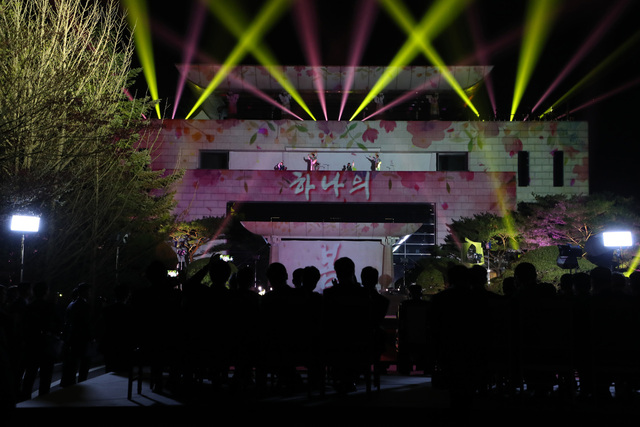 |
|
While South Korean President and North Korean leader Kim Jong-un proclaimed a “Spring of One” during the Apr. 27 Inter-Korean Summit, will they be able to similarly declare that “fall has arrived” during the upcoming summit in September? The above photo depicts the “Spring of One” ceremony and performance after the Apr. 27 Inter-Korean Summit. (Blue House photo pool)
|
Announcement by WPK’s Rodong Sinmun effectively sets meeting in stone
North Korea’s Rodong Sinmun newspaper reported on Aug. 14 that an agreement had been reached to hold a meeting and summit between the South and North Korean leaders “in Pyongyang within September.” The immediate announcement of the agreement through the Workers’ Party of Korea (WPK) newspaper – which occupies a position of overwhelming authority in North Korea – effectively sets the meeting in stone. It is a message indicating that despite fears to the contrary, the Pyongyang summit next month will happen as agreed upon. Then, will the third meeting between South Korean President Moon Jae-in and North Korean leader Kim Jong-un this September be closer to their Apr. 27 summit, which led to the “Panmunjom Declaration for Peace, Prosperity and Unification of the Korean Peninsula,” or the May 26 summit that resurrected the fading prospects for a North Korea-US summit? Agreement to hold fall summit also driven by sense of desperation to remedy stalemate To begin with, it is closer to the Apr. 27 summit in terms of form and protocol as an “official summit” in accordance with President Moon’s agreement to visit Pyongyang for a summit in the Panmunjeom Declaration. But the two sides’ agreement to hold an early fall summit is also informed by a sense of desperation: their need to remedy a situation where implementation of the Panmunjeom Declaration is struggling amid the bottleneck that has emerged in implementing the terms of Pyongyang and Washington’s June 12 Joint Declaration, including the matters of a declaration ending the Korean War and the reporting and inspection of nuclear facilities and materials. Official meeting in form, one-point meeting in political situation In terms of its key aims, the summit is closer to the so-called “one-point” meeting on May 26, which took place unannounced in a bid to revive the North Korea-US summit chances. A considerable gap is present between the summit’s form/protocol on one side and the political situation and aims on the other. For this reason, conflicting perceptions and explanations have been detected not just in the press and among experts, but from the administration as well. The Pyongyang summit in September is to be an official summit with an agreement issued in document form. Three of the four summits held to date in the history of inter-Korean relations have been official summits. In each case, a written agreement has been produced to serve as a signpost for inter-Korean relations: the June 15 Joint Declaration in 2000, the October 4 Joint Declaration in 2007, and the Panmunjeom Declaration this past Apr. 27. Only in the case of the “one-point” summit on May 26 did each side issue its own set of summit conclusions without a written agreement. Early on, President Moon and Kim left the matter of large-scale economic cooperation to furnish a material basis for shared prosperity as a matter to be addressed during the former’s “visit [to] Pyongyang this fall.” The reason had to do with sanctions by the US and UN. The idea had been to use the positive feedback loop in inter-Korean and North Korea-US relations from the Apr. 27 and June 12 summits to hasten denuclearization and achieve some progress in lifting at least the sanctions connected with the North Korean public’s livelihood by the time of the fall summit. But progress in the political situation has been far too slow for the two sides to declare that “fall has arrived” as initially envisioned. After high-level talks on Aug. 13, South Korean Minister of Unification Cho Myoung-gyon explained that the September summit in Pyongyang was being pursued because of “issues that need to be discussed by the leaders in terms of historical developments in inter-Korean relations, peace on the Korean Peninsula, and the denuclearization issue.” Meaningful developments necessary for summit’s success For the two agenda items to be included in written agreement form at the fall summit, there will need to be meaningful progress beforehand on the war-ending declaration and denuclearization matters with US Secretary of State Mike Pompeo’s visit to Pyongyang, along with practical progress in areas including the opening and operation of a joint liaison office in Kaesong and cooperation in the areas of railways, roads, and forestry. It’s a tall order to achieve in the space of one month. For that reason, one former senior official acquainted with the Korean Peninsula situation suggested a “realistic target” for the September summit “will need to be set somewhere between a ‘one-point summit’ and the ‘fall visit to Pyongyang’ where they were initially planning to declare that ‘fall has arrived.’” Commenting on the September summit in Pyongyang, a Blue House official said that South Korea “never made a request” at high-level talks on Aug. 13 for President Moon’s presence at the Sept. 9 holiday commemorating the DPRK’s foundation. By Lee Je-hun, senior staff writer Please direct comments or questions to [english@hani.co.kr]






